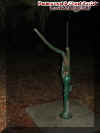|
|
||

On my journeys down here in Florida I
have come to realize that even the smallest towns have alot of history.
Some die out some boom into cities. While others remain still very old
fashioned or slowly decline. Sorrento is not a very large town but the
one thing that stands out about the town is its Cemetery cause the
burials here have alot to do with the towns history.
The cemetery sits down a country road
its surrounded by ranches and its a pretty peaceful place. Their is
woods towards the back and the graves are very sparse. Below you will
find a history to the cemetery and the town. I mean its a very well
maintained place for being in such seclusion their is even a shelter
where you can sit down and reflect.
I do feel that the history is relevant
to the cemeteries not so sure if it is that haunted their is energy
present though it was a very artsy and town full of talented people.
© By
Lord
Rick-LordOfThyNight
A BRIEF HISTORY OF SORRENTO, FLORIDA
By Miss Hattie Allen
When the first white settlers came in 1875, this was part of Orange County and Orlando was the County Seat. In 1887, Lake County was created from parts of Orange and Sumter Counties and Tavares became the County Seat. The first white man to settle in this section was a Mr. Lyons in 1875. Information about him is lacking. Later the same year, Mr. William Buts with his wife, two sons and two daughters, came from Missouri. They drove in from Melonville which they had presumably reached by boat on the St. John’s River. Mr. Butts took up a homestead a mile and one-half west of the present Sorrento post office and he and each of his sons, Calvin and Warren, built cabins and planted orange groves. About this time, five young men came from Ohio. They were Ed Averill, Charles Adams, and his brother Joe, A.S. Matlack and H.B. Paxton, all bachelors. Some took up homesteads and others bought smaller parcels of land. All built cabins and planted groves and three of them became permanent Florida citizens. These first white settlers found several colored families living about a mile north of Sorrento. They were slaves and children of slaves from the plantation of Mr. Delk at Rock Springs. When freed at the beginning of the Civil War, some joined the Union Army, but at the close of the war they returned to settle near the home of their mother, Aunt Hettie Weir, from whom many of the early settlers bought their first orange trees. Two other colored families lived on the Rock Springs road - Uncle Pete and Aunt Mary Frazier and their children and Joe Jenkins and his family. Their descendants still live in this section. Wild game was plentiful. Bear, wolves and panther traveled from the Big Scrub at the north to the hammocks along the Wekiva River and Rock Springs Creek. Deer were common as late as 1884. Mr. Gill, who homesteaded on Lake Beauclaire, south of Sorrento, sold his property to Mr. Dudley Adams and bought mules and a wagon to establish a route from Mount Dora to Melonville. There were seven families along the way. As some of them lived at a distance from the road, Mr. Gill carried a cow horn which he blew when approaching a home. The residents would then bring their out-going mail and grocery lists to him and on his return trip he would deliver their orders and incoming mail. He made one round-trip each week. A regular boat line from Jacksonville to Astor on the St. Johns River brought in passengers and freight. A narrow gauge railroad connected with Fort Mason. From there, travel was by horse and wagon. About 1880, Mr. and Mrs. J.P. Kerr and family arrived from Indiana, Mr. and Mrs. A. K. Reeve and son from Brooklyn, and Mr. and Mrs. Miner and daughter from Milford, Connecticut. All built homes here. By this time, a mill at Seminole Springs was supplying lumber and also, Mr. William Summerville had a mill on Wolfe Branch Road. Mr. Butts established a brick mill on his homestead. He was joined in business by Mr. Edward Budgeon in connection with the large lumber mill of Mr. Lovejoy. A name was needed for the little settlement and as the residents had been reading a new book called, “Agnes of Sorrento”, and as the fruits and flowers of Italy’s Sorrento were so much like what they wanted for their Florida homes, the majority voted to name the new town, Sorrento. Mr. Averill built a hotel and a small store building which he stocked with groceries. Later, he sold the property to Dr. Thomas, a retired physician from Ohio, who operated the hotel from 1882. The store was sold to A.S. Matlack and C. G. Adams. This firm was later joined by A. E. Allen and the store, in a larger building, served the community and surrounding country for more than sixty years. In 1881-82, Mr. William Allen and his son, Arthur Allen, from Ohio, had bought land and before the year was out, had built houses, planted groves and brought their families. Later, William Allen built a store on his property about a mile south of the Sorrento Post Office. At this time, Arthur Allen clerked in his father’s store and a younger brother hauled the supplies from Fort Mason, leaving before daylight and returning after dark from the ten-mile trip over deep sandy roads. About 1885, Mr. and Mrs. A. L. Emerson and their three children came from Cleveland, having bought a grove near the Allens. Mrs. Emerson was a sister of William Allen. The next year, Mr. and Mrs. George Dowler came from Ohio. Mrs. Dowler and Mrs. A E. Allen were twin sisters. Other families who were here in the early days but whose dates of arrival we do not know, include: Mr. and Mrs. Summerville from Massachusetts, whose daughter, Flora, was the first child born in the new town. Mr. and Mrs. Alf Woodcock of Massachusetts. Mr. Woodcock was Mrs. Summerville’s brother. Mr. and Mrs. McCauley and daughter from Ohio. Mrs. Brown and daughter, Mabel. Mr. and Mrs. Howard and family from Wisconsin. The Gillettes, the Needhams, the Registers, the Daughterys, the Brooks, the Mitchells, the Revels and Dr; Hause, a dentist. One of the first buildings for the use of the public was a Town Hall built by a stock company of early citizens. One of the first organizations was the Sorrento Literary Society, which had a monthly program and business meeting in the Town Hall. This society owned its own organ, had several excellent musicians and staged home-talent plays, arranged basket suppers, ice cream socials, dances, etc. and on the Sabbath, a community Sunday School was conducted and ministers of different denominations preached the sermons. In 1883, the Presbyterian Church was organized and in 1884, the Ladies Aid Society began its work which has continued to the present day. In 1886, the church building was opened with Rev. C M. Livingston of New York City as its first pastor. Mr. Livingston and his wife and daughter, Grace, then a charming young lady, lived at the Averill house. Grace Livingston later became a well -known novelist, writing as Grace Livingston Hill. The hotel in the pine woods had some quite famous guests. Among them were Miss Rose Cleveland, sister of President Cleveland; Miss Boise, sister of Senator Boise of Idaho; Dr. and Mrs. Alden and the latter being a well-known author, using the pen name of “Pansy”. The Sorrento Improvement Society was organized quite early in the history of the village. The men and boys gave a day of work in laying out streets and clearing them, while the women prepared a big dinner which was served at noon in the Town Hall. The giant oak trees of today are a monument to the workers of those early years who set them out as saplings along the highways. The Field Days were happy community affairs. Land for a cemetery was given from the homestead of Mr. Calvin Butts and was cleared by this same organization. It was laid out in lots and blocks, numbered and a large plat was made by Mr. A. S. Matlack. He also made a plat of the village, all free service for the place he loved. The Town Hall was used as a public schoolhouse and the early teachers were of the community: Prof. A .K. Beam from Ohio, Miss Brooks from Ohio, Mrs. Henry Reeve, a former teacher in Brooklyn, Prof. Dodson from Iowa and Mrs. Thomas, a teacher of languages in Wooster College, Ohio before coming to Florida. She also taught advanced pupils in private school. The Jacksonville, Tampa and Key West Railroad was completed and a branch line from Sanford to Tavares through Sorrento brought more people into this section. The first trains were running for passengers and freight in 1886. Groves were coming into bearing, packing houses were built, a drugstore was opened by Dr. Bliss from Cedar Rapids, Iowa, and a newspaper, “The Florida Highland Press” with Phillip Isaacs as editor and Frank Horton , his assistant, was published in a new printing office. The ladies organized a Chautauqua Reading Circle. All these activities increased the village’s usefulness and it became an important shopping and shipping point for the surrounding country. In the early days, one of the pleasures was community or family picnics to the Springs. Seminole, Rock and Clay, now called Wekiwa, were all in driving distance even though good roads had not been heard of and transportation was by horse and wagon. The wagon drawn by the little donkeys, brought from Michigan by Mr. Burmann and the big mule team driven by Mr. Woodcock, were ready to start early in the morning. They were loaded to capacity, children on the laps of their parents and well-filled baskets in the center of the wagons. These were important and long anticipated occasions and everyone was happy. The day was spent in bathing, boating, fishing and the all-important dinner at noon. If the picnic was at Wekiwa, Rock Springs was the stopping place on the way home, for rest and more good eats from the baskets which were still far from empty. Then on again toward home, a tired but happy group, singing, talking, discussing the affairs of the village and of the world. Another summer enjoyment was the ice cream social held by the Ladies Aid Society at the Town Hall. Ice was brought in by train after the railroad came through but before that, it was hauled by horse and wagon for these special occasions. The ten gallon freezers were turned by hand and the children waited for a taste of the cream when the dashers were removed and the cream was packed to harden. The ice cream and homemade cakes were sold to all comers and the money cleared was used for the church or community projects. Birthdays and anniversaries were celebrated with surprise parties, each guest bringing a cup of sugar and later receiving a saucer of taffy to be pulled until it was white and creamy. Thanksgiving meant a community dinner at the Town Hall and Christmas was celebrated at the Church with a great Christmas tree, a program of music and recitations and presents for everyone. Santa Claus never failed to appear and he never overlooked anyone when he distributed the gifts. The hour was late when the festivities were over, the calls of a Merry Christmas were heard, as in wagons, buckboards or walking, the happy, friendly people returned to their homes in the village or on their groves among the pine woods. This writer can still see in memory, the twinkling lanterns moving off in all directions and hear the children saying, “There go the Allens”, or “That must be the Registers”, and “The Emersons are just starting up the hill”.
This material which covers Sorrento history up to about 1894 and the BIG FREEZE, was compiled by Miss Hattie Allen, daughter of Arthur E. Allen and granddaughter of William Allen. She is the only one of those who came to Sorrento in 1882 who still resides here. The FREEZE was a major catastrophe, not only destroying the crop, but killing the trees to the ground. Many gave up and returned to their former homes, but those who stuck it out, finally saw their trees once more bearing the luscious golden fruit. Later came big packing houses, a prosperous turpentine still and a large sawmill operated by George and Frank Battle. These things, with the coming of good roads and automobiles, brought in many new settlers, many of them retired people. A large hotel and golf course, with many attractive residences, was built at Mt. Plymouth, about two miles to the southeast. The town itself has not grown much in size as Mt. Dora is only five miles away, but it is, as in the early days, a settlement of cultured, musical and artistic people and a quiet but happy community.
|
||
|
|
|













